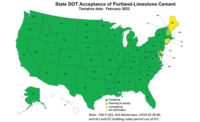
Mark Cullington
Operations Director and Vice President
Kennedy Jenks
Like in much of the Pacific Northwest, things are looking bright for the A/E/C industry in Portland, Ore., says Mark Cullington at Kennedy Jenks.
“We’re continuing to see growth in the construction sector and the engineering design sector,” says the company’s Portland-based operations director and vice president.
Like much of the industry, the region has seen a solid recovery from the pandemic-related slowdown, and that rebound is expected to gain momentum. And one impressive aspect of the growth is the wide range of sectors it includes.
“Investment in tech in Oregon is continuing to grow,” says Cullington. “Health care is growing. Leisure and recreation continue to grow. And the infrastructure work for all of this, which you don’t often see, is tremendous.”
One key piece of infrastructure being addressed in Portland is water infrastructure. According to DODGE, environmental public works starts reached a whopping $1.15 billion in 2022. A key reason was the $420-million Willamette Water Supply System Water Treatment Plant, which is projected for completion in March 2026. The seismically resilient facility will treat 60 million gallons per day initially, with future expansion capabilities to accommodate a total of 120 MGD.
The plant is part of the $1.3-billion Willamette Water Supply Program that will supply drinking water to communities west of Portland served by the Tualatin Valley Water District. Kennedy Jenks is one of a host of companies participating in the water supply projects and the pipelines that are part of the overall effort.
An important driver of work in the sector is Oregon’s Clean Water State Revolving Fund Program, Cullington says. The program works like an environmental infrastructure bank by providing below-market rate loans to eligible recipients for water infrastructure projects.
“There are lots of communities that take advantage of that,” he says. “They’re using it to capitalize and pay for the design and construction of a lot of these facilities.”
One of the challenges this sudden largess poses for the industry is finding enough trained people to handle the amount of work. Staffing isn’t simply a matter of filling open positions, it’s an ongoing process of meeting the needs of the workforce, Cullington says.
“We need to be proactive and responsive to the demands in the labor market, be it recruiting, hiring and maintaining qualified professional staff,” he says.
Cullington adds that affordable housing is a constant consideration for Kennedy Jenk’s forecasting, with engineers and specialty professionals in high demand. And Portland has seen a strong surge in residential building. Project starts for the region are expected to top $3.6 billion this year, surpassing the pre-COVID peak, and reach $4 billion in 2024. Cullington says a host of state initiatives to encourage housing developments have been a key factor for the upswing.
Portland has not been immune to supply chain problems and the rising costs of materials. Cullington says it’s something the industry is working their way out of using the benefit of hindsight.
While issues with long lead times have not been completely resolved, there has been a noticeable improvement in the ability of owners, designers and contractors to preplan and meet those issues.
“A lot of people in the industry learned some really hard lessons during COVID and now, weirdly enough, it’s starting to pay off,” he says.
Transportation infrastructure has been another area of steady growth that shows signs of gaining even more speed in the next few years. According to DODGE, highway and bridge starts in 2023 will reach $528 million, more than double the 2020 total.
One critical transportation project much of the region is anxiously awaiting is the long-delayed I-5 bridge spanning the Columbia River between Oregon and Washington. Last year each state committed $1 billion to the project, a key step to attain eligibility for federal funding.
As for air transportation, the Portland Airport’s $2-billion PDX Next project continues to race to a 2025 conclusion. The centerpiece of the project, a 9-acre new main terminal featuring a locally sourced timber roof, is on track for completion next year.
“We love PDX,” Cullington says. “It’s an easy airport to get in and out of. It helps with the tourism, business and leisure of the region.”





